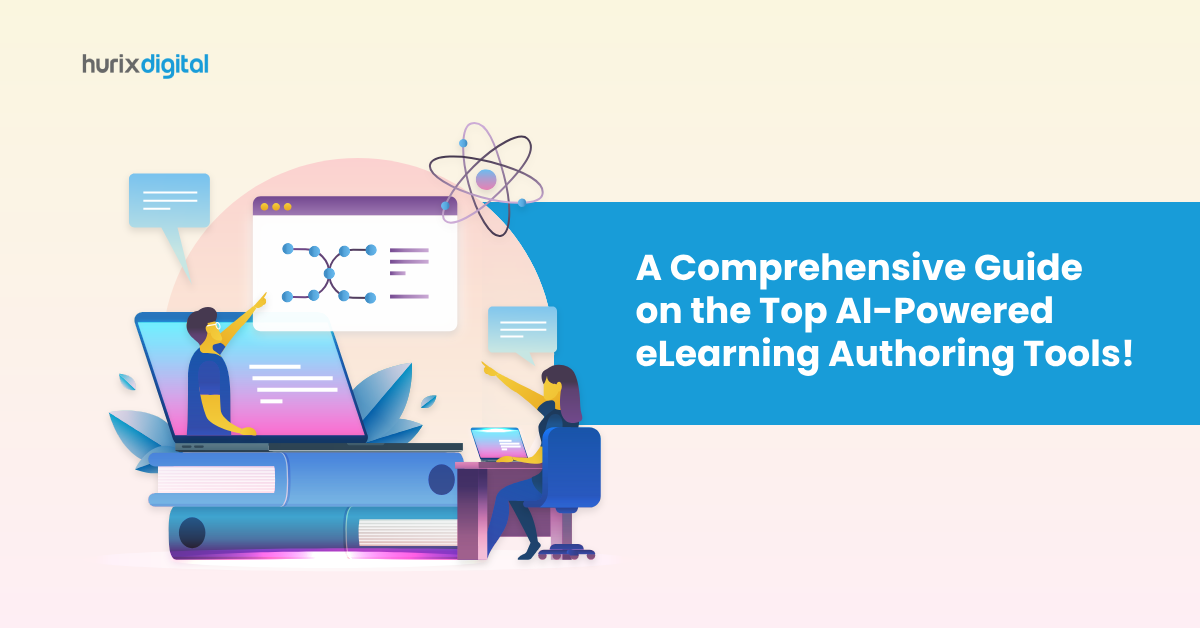A Comprehensive Guide on the Top AI-Powered eLearning Authoring Tools
In the ever-evolving world of eLearning, artificial intelligence (AI) is rapidly changing the landscape. The days of clunky content creation and one-size-fits-all learning experiences are fading, replaced by personalized, interactive, and immersive journeys powered by AI.
Gone are the days of static, monotonous courses – AI-powered authoring tools are now infusing dynamism, collaboration, and efficiency into the learning experience.
For eLearning professionals, navigating the complexities of AI-powered authoring tools can be daunting. With so many options available, choosing the right platform for your needs is crucial. This comprehensive guide is here to equip you with the knowledge you need to identify and utilize the top AI-powered eLearning authoring tools for your courses.
Table of Contents:
- What are AI-powered eLearning Authoring Tools?
- Exploring Leading AI-Powered eLearning Tools
- Choosing the Right Tool: Matching Your Needs with the Platform’s Strengths
- Three Tips for Using AI-Powered eLearning Authoring Tools Effectively
- Key Takeaways
What are AI-powered eLearning Authoring Tools?
These tools are the next generation of eLearning software with AI algorithms that streamline content creation, enhance learner engagement, and personalize the experience. The global collaborative eLearning authoring tools have gained traction and will continue to grow with a forecasted CAGR of 13.1% respectively.
Unlike traditional tools that primarily focus on content authoring, AI-powered authoring tools offer additional features like:
- Smart content generation: Generate text, quizzes, multimedia, and personalized learning paths using AI templates and algorithms.
- Adaptive learning: Tailor the learning journey based on individual learner needs and performance, adjusting difficulty levels and suggesting relevant content.
- Automated feedback and assessments: Use AI to provide personalized feedback on assignments and assessments, saving instructors valuable time.
- Immersive experiences: Leverage AI to create interactive simulations, AR/VR environments, and gamified elements for enhanced engagement.
- Data-driven insights: Gain valuable insights into learner progress and course effectiveness through AI-powered analytics dashboards.
Exploring Leading AI-Powered eLearning Tools
With the AI landscape constantly evolving, the list of top contenders is subject to change. However, some established players have already earned their stripes:
1. Paradiso Composer
Featuring a user-friendly interface and customizable AI voiceover templates, Paradiso Composer excels in rapid content creation. The AI capabilities generate text, quizzes, and even video scripts based on your input. It also offers powerful features like adaptive learning and supplemental content.
2. Adobe Captivate
A well-known name in the eLearning world, Captivate has embraced AI with fervor. Its interactive learning path recommendations and personalized widgets functionality enhance learner engagement, while its simulations provide valuable insights into course performance.
3. CogniSpark AI
This unique platform focuses on integrating AI tutors within your courses. These virtual tutors engage learners in personalized conversations, answer questions, and provide guidance, creating immersive and interactive learning experiences.
Also Read: eLearning Authoring Tools: Why You Should Invest in them?
4. Elucidat
Known for its intuitive interface and collaborative features, it’s part of the cloud-based tools that leverage AI to personalize learning paths and deliver adaptive assessments. Its user-friendly environment further enhances knowledge retention and engagement.
5. Lectora Inspire
This powerful authoring tool has recently incorporated AI-powered feedback analysis, helping instructors assess learner progress more efficiently. Its robust quizzing engine and branching scenarios also contribute to personalized learning experiences.
Choosing the Right Tool: Matching Your Needs with the Platform’s Strengths
With so many great options available, finding the perfect AI-powered eLearning authoring tool requires careful consideration. Here are some key factors to ponder upon:
- Budget: AI-powered tools can be pricier than traditional ones. Compare pricing models and consider your organization’s budget before making a decision.
- Target Audience: Take into account the learning needs and preferences of your audience. Choose a tool that caters to their specific requirements and learning styles.
- Ease of Use: If you’re not tech-savvy, opt for a user-friendly platform with intuitive features and minimal technical know-how.
- Content needs: Does your content require text generation, multimedia creation, or adaptive learning features? Choose a tool that caters to your specific needs.
- Technical expertise: Some tools require greater technical understanding than others. Assess your team’s comfort level with technology before diving into AI functionalities.
- Scalability: Will the platform cater to your current and future needs? Think about the size and complexity of your courses when making your choice.
- Integration with Existing Systems: Ensure the tool seamlessly integrates with your existing Learning Management System (LMS) and other eLearning platforms you use.
Three Tips for Using AI-Powered eLearning Authoring Tools Effectively
The field of AI is constantly upgrading. Keep abreast of the latest developments and advancements in AI-powered eLearning tools to ensure you’re using the most effective and innovative approaches:
1. Prioritize Instructional Design Principles
Focus on crafting clear learning objectives, engaging content, and meaningful assessments. Use AI to enhance these elements rather than dictate them. Ensure that the AI features you employ align with your chosen teaching approaches and learning theories.
2. Balance AI and Human Input
AI can generate interactive eLearning content and automate tasks, but human oversight is crucial to ensure quality, accuracy, and relevance.
Review AI-generated content, provide context and guidance, and personalized feedback to complement the AI’s capabilities. Facilitate discussions and create a more engaging and supportive learning environment.
3. Monitor and Evaluate Continuously
Leverage the data generated by AI tools to track learner progress, identify areas for improvement, and personalize learning paths even further. Use this data to make informed decisions about content adjustments, instructional approaches, and resource allocation.
Seek feedback regularly from learners on their experiences with AI-powered courses. This feedback can help you gauge the effectiveness of the AI features, identify any usability issues, and ensure the tools are meeting learners’ needs and expectations.
Also Read: Top Five eLearning Authoring Tools for 2024!
Key Takeaways
The integration of AI in eLearning courses is still in its early stages, but the future promises exciting possibilities. Imagine AI-powered tools that automatically adapt content based on real-time learner emotions, create personalized learning experiences based on individual strengths and weaknesses, and even diagnose learning gaps and difficulties proactively.
This, however, requires responsible development and ethical considerations. As AI continues to evolve, it’s our responsibility to ensure its usage promotes inclusivity, accessibility, and a safe learning space for all.
AI-powered eLearning authoring tools are revolutionizing the way we create and deliver learning experiences. At Hurix Digital, we leverage the power of AI to create engaging, personalized, and effective learning journeys for our learners. Try the free demo today!

SVP & Head – Hurix Technology Solutions
Global Delivery head with 25 years of working experience in NYC investment banks and fintech companies. Hands-on technology delivery management and program management, accountable for stakeholder relationships, Strategic roadmap, P&L, Revenue growth, Account Management, and employee satisfaction.









